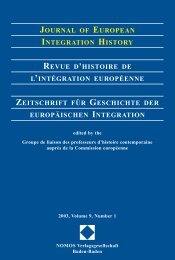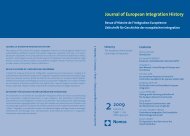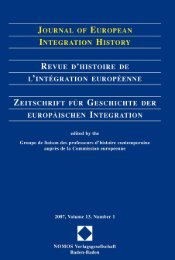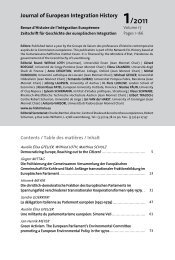journal of european integration history revue d'histoire de l ...
journal of european integration history revue d'histoire de l ...
journal of european integration history revue d'histoire de l ...
Create successful ePaper yourself
Turn your PDF publications into a flip-book with our unique Google optimized e-Paper software.
Choosing the Periphery 87<br />
economy during the following twenty-five years was due to the governmental <strong>de</strong>sire<br />
to maintain them.<br />
Growth policy from 1945 was <strong>de</strong>signed on a long-term basis and for structural<br />
reasons it was based on exports. Governments gave priority to <strong>de</strong>veloping the merchant<br />
navy and the export industries based on inexpensive hydroelectric power.<br />
Throughout the 1950s and 1960s foreign tra<strong>de</strong> constituted approximately forty per<br />
cent <strong>of</strong> Norway's Gross National Product (GNP). Export revenue was thus <strong>de</strong>cisive<br />
for the national revenue. In the long run, exports would eventually provi<strong>de</strong> income<br />
to finance the many ambitious mo<strong>de</strong>rnisation programmes, including the welfare<br />
state. Most <strong>of</strong> the export economy required a heavy <strong>de</strong>gree <strong>of</strong> imported capital,<br />
such as machinery and raw materials. For example, means <strong>of</strong> production constituted<br />
as much as eighty-eight per cent <strong>of</strong> all imports in 1955. The capital requirements<br />
ma<strong>de</strong> Norway a net importer <strong>of</strong> capital. In 1956 gross <strong>de</strong>bts to foreign len<strong>de</strong>rs constituted<br />
twenty-five per cent <strong>of</strong> the GNP. During the next <strong>de</strong>ca<strong>de</strong> this tripled in absolute<br />
terms, corresponding to thirty-six per cent <strong>of</strong> the GNP.<br />
The financial problem <strong>of</strong> Norway's mo<strong>de</strong>rnisation strategy was always lack <strong>of</strong><br />
capital and the danger that international preference areas got in the way <strong>of</strong> export<br />
revenues. The corollary was that the Norwegian governments were liable to participate<br />
in international preference areas that were appropriate for their specific growth<br />
policy. In<strong>de</strong>ed, from the perspective <strong>of</strong> current and capital accounts, the Norwegian<br />
government always argued at the OEEC Council <strong>of</strong> Ministers that quota liberalisation<br />
occurred too rapidly, the terms <strong>of</strong> payments in the EPU were too hard, while<br />
also <strong>de</strong>ploring the transition to convertibility. However, it always <strong>de</strong>fen<strong>de</strong>d the<br />
OEEC co-operation schemes in any domestic political <strong>de</strong>bate. Within the government<br />
itself the impact that investment needs had on the country's foreign commercial<br />
policy was stated more precisely. When discussing the problems that would<br />
arise from convertibility, Arne Skaug, then ambassador to the OEEC and later minister<br />
<strong>of</strong> Tra<strong>de</strong>, argued that<br />
“in the future the Norwegian economy will <strong>de</strong>pend on, <strong>de</strong> facto if not <strong>de</strong> jure, Norway<br />
participating in a greater economic unit. Others rather than ourselves must do<br />
the savings and provi<strong>de</strong> the capital formation we need to <strong>de</strong>velop our industries”. 33<br />
In the following section I will show that support for an OEEC-wi<strong>de</strong> industrial free<br />
tra<strong>de</strong> area in 1957-58, as well as EFTA membership in 1960, was a logical consequence<br />
<strong>of</strong> the export-oriented growth policy, which also led to interest in the EEC.<br />
In accordance with the compromise ma<strong>de</strong> in 1935, the tra<strong>de</strong> union movement<br />
and industrial organisations supported export-led growth as a mo<strong>de</strong>rnisation strategy.<br />
Industry was to be ma<strong>de</strong> competitive, and through incomes policy the governments<br />
sought to mo<strong>de</strong>rate wages to respond to variations in international-market<br />
conditions. Wage mo<strong>de</strong>ration would be exchanged for investments. Gross investments<br />
would normally lie at above thirty per cent <strong>of</strong> the GNP and be subjected to<br />
planning. The interest rate was kept artificially low to stimulate the <strong>de</strong>mand for pri-<br />
33. Riksarkivet, Oslo [National Archives] (henceforth RA), Privatarkiv Knut Getz Wold [Private archive<br />
<strong>of</strong> Knut Getz Wold], box 169, Note on convertibility by Arne Skaug, 14 October 1953.

















